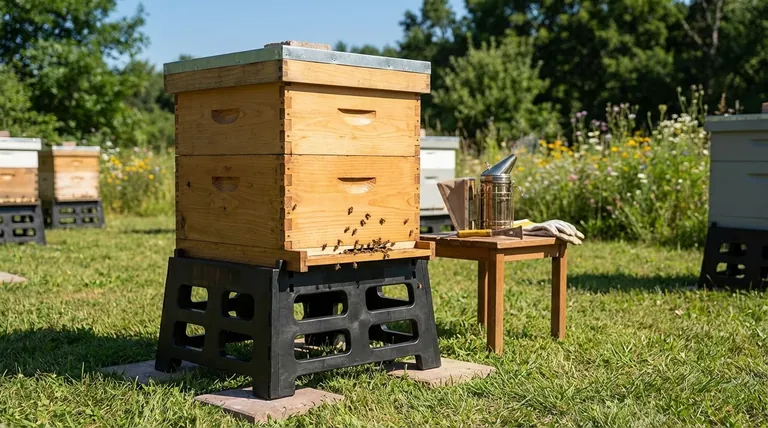For a beehive stand, a height of 12 to 18 inches is the established best practice. This range is high enough to protect the hive from ground moisture and common pests while remaining low enough to allow for safe and comfortable hive inspections and lifting of heavy honey supers.
The ideal height for your hive stand is not a single magic number, but a calculated balance. It's the point where beekeeper comfort, hive protection, and operational stability all converge.

Why Hive Stand Height Matters
Elevating your hive is one of the first and most critical decisions you will make for your apiary. The height you choose directly impacts the health of your bees and the sustainability of your beekeeping practice.
Protecting Your Back: Beekeeper Ergonomics
A stand that is approximately 16-18 inches high places the hive's heaviest boxes (the brood boxes) at a comfortable working height. This significantly reduces the need to bend over during inspections, minimizing strain on your back and knees.
Working with a hive on the ground requires constant deep bending, which is uncomfortable and can lead to injury over time.
Defending Against Pests and Predators
Raising a hive off the ground is a simple and effective form of pest management.
An 18-inch elevation makes it difficult for skunks to stand on their hind legs and scratch at the entrance to lure out and eat guard bees. It also helps deter toads and reduces access for rodents seeking warmth in the winter.
Ensuring Proper Airflow and Moisture Control
One of the greatest threats to a colony, especially during winter, is moisture. Placing a hive directly on the ground allows dampness to seep into the wood, promoting mold, mildew, and wood rot.
An elevated stand allows for crucial airflow underneath the hive, keeping the bottom board dry and helping the colony better regulate its internal temperature and humidity.
Creating a Clear Flight Path
A raised hive entrance stays clear of tall grass, weeds, and snow. This ensures the bees have an unobstructed flight path and prevents vegetation from blocking ventilation.
Understanding the Trade-offs
While the 12-to-18-inch range is ideal, there are trade-offs to consider at either end of the spectrum. Choosing a height involves balancing competing priorities.
The Stability Factor
The higher you go, the more critical stability becomes. A tall, narrow stand on uneven ground is a tipping hazard, especially in high winds or if bumped by animals or equipment.
Always ensure your stand is level and resting on a firm, stable foundation, such as pavers or a concrete slab. A wider base adds significant stability.
The Weight of Supers
While a higher stand is better for inspecting lower boxes, it can make lifting heavy honey supers onto the top of the hive more challenging. An 18-inch stand is generally considered the upper limit for safely lifting a full super (which can weigh over 50 pounds) without excessive strain.
Cost and Materials
Simple cinder blocks are inexpensive and provide a stable 16-inch height when placed on their side. Custom-built wooden or metal stands offer more features but require a greater investment of time or money. The material itself does not dictate success, but the final height and stability do.
Making the Right Choice for Your Apiary
Select your hive stand height based on your physical needs, local environment, and beekeeping goals.
- If your primary focus is personal comfort and ease of lifting: Aim for the lower end of the range, around 12-16 inches, to minimize the height you need to lift heavy honey supers.
- If your primary focus is maximum pest protection and airflow: Aim for the higher end, around 18 inches, especially if skunks are a known issue in your area.
- If you are in a high-wind area or on uneven ground: Prioritize a lower, wider, and more stable base, perhaps using two stacks of cinder blocks to create a very secure platform around 16 inches high.
Ultimately, a well-chosen hive stand is the foundation for a healthy colony and an enjoyable beekeeping experience.
Summary Table:
| Recommended Height | Primary Benefit | Best For |
|---|---|---|
| 12-16 inches | Easier lifting of heavy honey supers | Beekeepers prioritizing personal comfort and ease of lifting |
| 16-18 inches | Maximum pest protection and airflow | Areas with skunk problems or high moisture concerns |
Build a Stronger Foundation for Your Apiary with HONESTBEE
Choosing the right hive stand height is just the beginning. The quality and durability of your beekeeping equipment are paramount to your success. HONESTBEE supplies commercial apiaries and beekeeping equipment distributors with robust, reliable supplies through our wholesale-focused operations.
We understand the demands of commercial beekeeping. Let us help you build a more efficient and profitable operation with equipment you can trust.
Contact HONESTBEE today to discuss your wholesale supply needs and elevate your beekeeping practice.
Visual Guide

Related Products
- Plastic Bee Hive Stand for Beekeeping
- Metal Hive Feet Bee Hive Stand for Ant Protection
- Metal Bee Hive Stand Bee Box Stand for Beekeeping
- Wholesales Dadant Size Wooden Bee Hives for Beekeeping
- Professional Drop-Style Hive Handles for Beekeeping
People Also Ask
- What are the advantages of polystyrene hives for beekeeping? Boost Colony Health & Honey Yields
- How do bees regulate ventilation and temperature in the hive? Master Hive Climate Control
- What is the purpose of a hive stand in a Langstroth hive? Protect Your Hive and Boost Colony Health
- Why is elevating the hive important? A Simple Step for a Healthier, More Productive Colony
- What are the advantages of a second hive if the queen is killed? The Ultimate Insurance Policy for Your Apiary



















